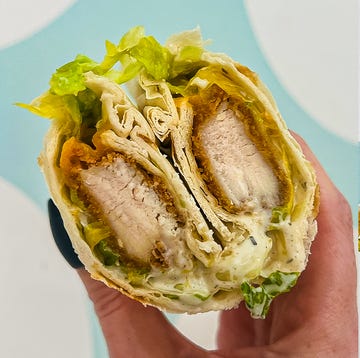11921: Where It All Began
 Jim Heimann Collection//Getty Images
Jim Heimann Collection//Getty ImagesAmerica's very first drive-in, Pig Stand, opened in 1921 and was located on the highway connecting Dallas and Fort Worth, Texas. This is the menu from 1938, after the brand took off and was franchised across the country.
2Circa 1930: Car Innovations
 University of Southern California//Getty Images
University of Southern California//Getty ImagesThe 1930s were a time of luxury transportation. With new innovations, like built-in heaters and radios, the idea of eating in your vehicle began to appeal to car owners more and more.
Advertisement - Continue Reading Below
31932: Dinner Made Easy
 University of Southern California//Getty Images
University of Southern California//Getty ImagesPeople loved getting food delivered right to their windows. It was a brand-new concept in an age where quicker was better and convenience was key.
41932: Affordable Eats
 University of Southern California//Getty Images
University of Southern California//Getty ImagesBack in the '30s, you could buy dinner with a few coins. At a California restaurant called Carpenter's, nothing was more than a dime and a nickel.
Advertisement - Continue Reading Below
51933: Come One, Come All
 Bettmann//Getty Images
Bettmann//Getty ImagesYou'd be served no matter what you pulled up in. Here, Old Hollywood actor Monte Blue is handed his food while driving a mini race car.
61935: Embracing Themes
 Hulton Deutsch//Getty Images
Hulton Deutsch//Getty ImagesThemed drive-ins were a big hit with consumers. Fun fact: This seafood restaurant was covered in 50,000 abalone shells. Genius!
Advertisement - Continue Reading Below
71939: A Festive Coffee Shop
 ullstein bild Dtl.//Getty Images
ullstein bild Dtl.//Getty ImagesAt this joint, drivers could stop by for a quick cup of joe and a bite at a coffee pot-shaped drive-in near Los Angeles.
81939: Even More Themes
 ullstein bild Dtl.//Getty Images
ullstein bild Dtl.//Getty ImagesIf you needed more proof themed drive-ins were the hottest thing of the '30s, here's The Twin Barrels in Los Angeles. The spot was known for (what else?) root beer.
Advertisement - Continue Reading Below
91939: And One More For Fun
 ullstein bild Dtl.//Getty Images
ullstein bild Dtl.//Getty ImagesWhile this restaurant, dubbed The Toed Inn, didn't sell anything frog-related, we bet many visited it just to see the, ehem, unique exterior.
101939: Star-Studded Parking Lots
 CBS Photo Archive//Getty Images
CBS Photo Archive//Getty ImagesCBS Radio stars Frances Langford and Kenny Baker take a snack break at a drive-in café near The Texaco Star Theater in California.
Advertisement - Continue Reading Below
11Circa 1940: Raise Your Glass
 ullstein bild Dtl.//Getty Images
ullstein bild Dtl.//Getty ImagesAfter prohibition ended in 1933, people found just about any and every reason to toast. Some drive-ins served alcohol—but hopefully not to the driver!
12Circa 1940s: Skate Right Up
 ClassicStock//Getty Images
ClassicStock//Getty ImagesWait staff—often on roller skates—were dubbed carhops. Waiters and waitresses first started going by this name in 1921, when automobiles were becoming more common.
Advertisement - Continue Reading Below
131945: A Restaurant Revival
 University of Southern California//Getty Images
University of Southern California//Getty ImagesAfter WWII ended in 1945, the American hospitality business boomed. With rationing no longer needed, people were willing to spend more and try new foods.
141948: Architectural Trends
 Wisconsin Historical Society//Getty Images
Wisconsin Historical Society//Getty ImagesCircular drive-ins allowed staff to get from the kitchen to the cars easier, and therefore became very popular.
Advertisement - Continue Reading Below
151948: Space Smarts
 Wisconsin Historical Society//Getty Images
Wisconsin Historical Society//Getty ImagesA major perk of opening a drive-in? No capacity limits. This allowed for more customers, and, as a result, a bigger profit.
161948: Air Conditioning Incentives
 Cincinnati Museum Center//Getty Images
Cincinnati Museum Center//Getty ImagesFrisch's Big Boy drive-in in Ohio clearly appreciated the appeal of A/C. Drivers could eat either in the cool restaurant or their cars.
Advertisement - Continue Reading Below
171949: Drive-In Groceries
 PhotoQuest//Getty Images
PhotoQuest//Getty ImagesIn the '40s, there were drive-in churches, movies, and even grocery stores. Because who needs a shopping cart when you've got your trunk?
181950: Keepin' Busy
 FPG//Getty Images
FPG//Getty ImagesTo keep up with demand of drive-ins during the '50s, some locations developed a new system: Sending meals—and bills—to cars by conveyor belt.
Advertisement - Continue Reading Below
19Circa 1950: Behind The Scenes
 Hulton Archive//Getty Images
Hulton Archive//Getty ImagesHere's what the other side of the system looked like. An employee loads the conveyor belts with meals for hungry customers. Pretty cool!
20Circa 1950: Fountain Drinks Over Water
 Minnesota Historical Society//Getty Images
Minnesota Historical Society//Getty ImagesIf the water at restaurants tasted a bit off in the '50s, that's because it probably was. The Clean Water Act wasn't passed until 1972, and the Safe Drinking Water Act in 1974. Many customers ordered Coca-Cola or a milkshake instead.
Advertisement - Continue Reading Below
Advertisement - Continue Reading Below
Advertisement - Continue Reading Below

































